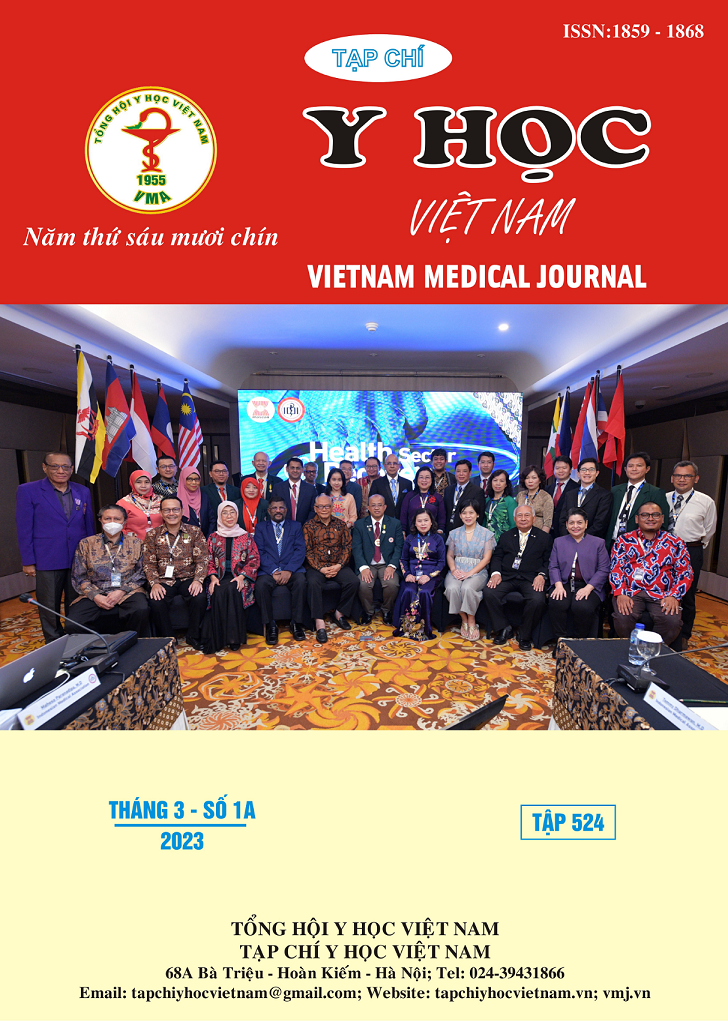EVALUATION OF EPICARDIAL ADIPOSE TISSUE THICKNESS BY TRANSTHORACIC ECHOCARDIOGRAPHY IN PATIENTS WITH CORONARY ARTERY DISEASE
Main Article Content
Abstract
Bacground: Recent studies have shown that epicardial adipose tissue thickness (EAT) can reflect cardiovascular risk and atherosclerotic plaque developement, particualarly coronary artery disease (CAD). Objective: To determine whether echocardiographic EAT thickness was correlated to the presence and extent of angiographic coronary artery disease. Subjects and research methods: A descriptive cross-sectional study on 146 patients with acute and chronic coronary syndrome who underwent transthoracic echocardiography and coronary angiography at the Interventional Cardiology Department, University Medical Center Ho Chi Minh city, campus 1, from March to June 2022. The echocardiographic EAT was measured at end-diastole from the long-and short-axis view of three cardiac cycles on the free wall of the right ventricle. The severity of CAD was assessed by Gensini score. Results: The mean EAT thickness in the parasternal long- and short-axis view were 5.0 ± 1.3 mm and 5.2 ± 1.2 mm, respectively. There was a significantly positive correlation between EAT thickness in parasternal long-and short-axis view and Gensini score (r=0.338 and r=0.340, respectively, p<0.001). Receiver operating characteristics (ROC) analysis showed that an EAT thickness of 5.3 mm in parasternal long-axis view was the optimal cut-off value for predicting the severity of CAD, with a sensitivity of 56.1% and specificity of 78.1% (AUC: 0.702, p<0.001, 95%CI: 0.618-0.787). EAT thickness in parasternal long-and short-view were significantly associated with diabetes (p=0.002 and p=0.022, respectively). Conclusion: EAT thickness assessed by transthoracic echocardiography was higher in patients with CAD than in patients without CAD. It is necessary to have more studies to evaluate the value of EAT thickness measured on echocardiography in predicting complexity of CAD as well as being an additional risk factor for CAD.
Article Details
Keywords
Epicardial adipose tissue, coronary artery disease, transthoracic echocardiography
References
2. Eroglu S, Sade LE, Yildirir A, et al. Epicardial adipose tissue thickness by echocardiography is a marker for the presence and severity of coronary artery disease. Nutr Metab Cardiovasc Dis. Mar 2009;19(3):211-7.
3. Meenakski. K. Epicardial fat thickness: A surrogate marker of coronary artery disease – Assessment by echocardiography. Indian Heart J. 2015;68(3):336-341.
4. Seker T, Turkoglu C, Harbalioglu H, Gur M. The impact of diabetes on the association between epicardial fat thickness and extent and complexity of coronary artery disease in patients with non-ST elevation myocardial infarction. Kardiol Pol. 2017;75(11):1177-1184.
5. Shambu SK, Desai N, Sundaresh N, Babu MS, Madhu B, Gona OJ. Study of correlation between epicardial fat thickness and severity of coronary artery disease. Indian Heart J. Sep - Oct 2020;72(5):445-447.
6. Sinha SK, Thakur R, Jha MJ, et al. Epicardial Adipose Tissue Thickness and Its Association with the Presence and Severity of Coronary Artery Disease in Clinical Setting: A Cross-Sectional Observational Study. J Clin Med Res. May 2016;8(5):410-9.
7. Wang Z, Zhang Y, Liu W, Su B. Evaluation of Epicardial Adipose Tissue in Patients of Type 2 Diabetes Mellitus by Echocardiography and its Correlation with Intimal Medial Thickness of Carotid Artery. Exp Clin Endocrinol Diabetes. Oct 2017;125(9):598-602.


